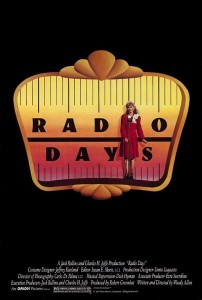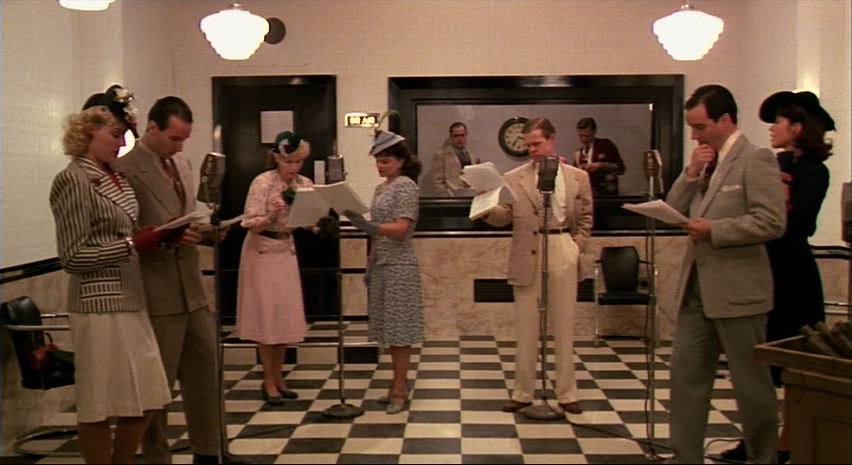|

Synopsis:
During the 1930s and ’40s, a young boy (Seth Green) and the members of his working class family — including his mother (Julie Kavner), his father (Michael Tucker), his unmarried aunt (Dianne Wiest), and others — find solace and excitement in a variety of radio shows.
|
|
Genres, Themes, Actors, and Directors:
- Comedy
- Ensemble Film
- Mia Farrow Films
- Radio
- Woody Allen Films
Review:
The final Woody Allen film listed in Peary’s book — actually included in his Addendum to the first printed edition — is this overtly nostalgic homage to Allen’s youth, a time when radio reigned supreme in households as the preferred mode of daily entertainment, news, and escape. While many of Allen’s previous films had included flashback scenes to a version of his childhood, this was the first to fully explore that particular era in American history, primarily through the lens of his alter-ego’s working class household — stuffed to the gills with not just his quibbling parents (Kavner and Tucker) but his married aunt (Renee Lippin) and uncle (Josh Mostel) and their teenage daughter (Joy Newman) as well as his single aunt (Dianne Wiest). Resolutely episodic in nature, the film portrays snippets from each character’s lives, most revolving in some way around radio — for instance, when Aunt Bea (Wiest) goes out on a date with a man she has hopes of possibly marrying, it’s Orson Welles’ Mercury Theater production of War of the Worlds that irredeemably dooms their nascent romance.
Meanwhile, several radio stars themselves come to all-too-human life — most notably the dapper male half (David Warrilow) of the morning radio show “Roger and Irene”, possessing an insatiable lust for a young cigarette girl (Mia Farrow) whose own infatuation with radio eventually blossoms in unexpected ways. Farrow’s trajectory is one of two the film perhaps follows most closely — the other being that of Wiest, whose desire to meet and marry Mr. Right clashes with her incurable pickiness. Farrow’s ditzy character remains a bit of a caricature, but Wiest turns Aunt Bea into a lovably neurotic soul we can’t help wishing the best for. But the primary memory one leaves the film with is that of a collective era, painstakingly recreated through Santo Loquasto’s period sets (and shot by DP Carlo di Palma).
Redeeming Qualities and Moments:
- Santo Loquasto’s impressive art direction


- A wonderfully nostalgic flashback to a distinct era of entertainment
Must See?
Yes, as an all-around good show. Listed as a film with Historical Importance in the back of Peary’s book.
Categories
- Good Show
- Important Director
Links:
|



One thought on “Radio Days (1987)”
A once-must at least, as Allen’s gentlest film.
I do love the way this film opens: burglars accidentally pulled into a phone call from a radio station announcer hosting ‘Name That Tune’. It’s a brilliant way to start a film; it sets things flying on a terrific upbeat with an energy unlikely for what will soon become a nostalgic piece.
Film memoir as obvious as this can be tricky territory (i.e., overly sentimental) but Allen achieves an admirable blend of wistful/zany. It’s also refreshing to sense Allen’s capture of *real* people (for the most part) – more or less average, normal folk who seem far removed from, say, most of the semi-annoying characters in ‘Hannah and Her Sisters’. Overall, it’s very easy and comfortable peeking in on the lives of the family ‘Radio Days’ focuses on. Their vignettes reveal instantly recognizable situations and emotions, many of which are indeed sweet.
Thanks to the more-than-considerable contributions by the entire production team, you really do feel you are there in the ’40s. The detail is overwhelming. The film has an enchanting flow as you’re swept along with the aid of countless kinds of radio shows and period music that almost seems to never stop.
The cast is uniformly appealing and convincing – and everyone appears to be really enjoying the project-at-hand. (It’s also a delightful surprise near the film’s end when Diane Keaton suddenly cameos with a rendition of ‘You’d Be So Nice To Come Home To’; she has a lovely voice and looks radiant.)
Strangely, then…this is only the second time I’ve seen this film. But it’s certainly a welcome addition to Allen’s body of work.